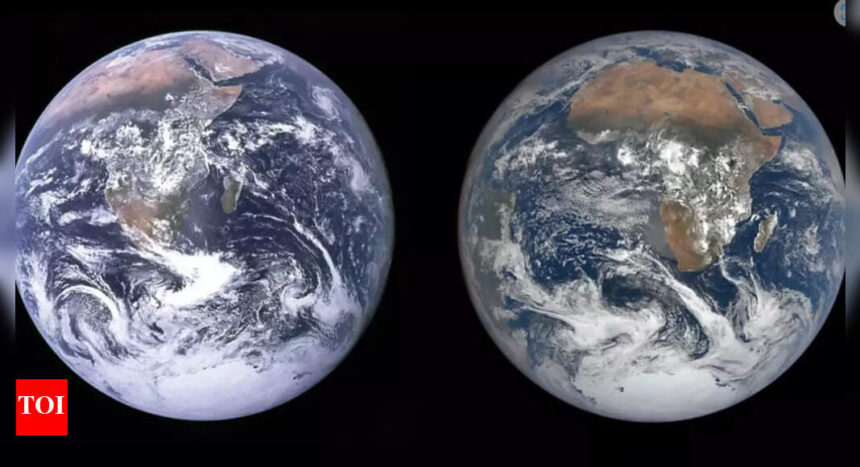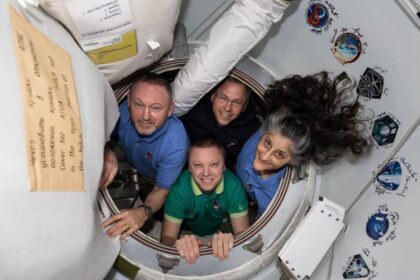Our Company Is The Prime News Network
NASA Reveals Earth’s Changing Image from Space
There was a time when looking at the sky was a source of wonder and fascination. The world seemed limitless, with its brilliant blue waters, green spaces, and dense layers of leaves. It symbolized harmony and beauty, full of natural wonders. From the outside space, the planet appeared magical. However, over the last decades, the complexion of our planet has changed dramatically, reflecting the cost to the environment of human actions. A once-pure image now presents a filthier scene, one of tension and decay.
NASA’s EPIC camera today captures the Earth in a much more troubled image. While the heavens still shine, they do not emit the same fierce blue that used to be the characteristic of our world. Melting oceans, felled trees, and blanket pollution have altered the hue of the world from above. The destruction that has already occurred to the planet can now be viewed from above, a harsh reminder of what has been achieved by decades of human neglect. Clean ecosystems are now scarred by global warming, and Earth’s once energetic vibrancy wanes.
Consequences of Ignoring Environmental Warnings
Since the 1970s, environmentalists have warned of the dangers of carbon emissions and the increasingly likely threat of global warming. These early warnings were characterised by consistent, systematic voices calling for action to avert the climate crisis that confronts us today. But despite the seemingly clear evidence, the world failed to act on time. Through the decades, these warnings became conclusive evidence. Glaciers melted, islands disappeared, and animals were pushed to the point of extinction, but the world failed to take action swiftly enough to prevent it.
Deforestation and the Amazon’s Struggle for Survival
The oceans that once teemed with life are also facing extreme alteration. Ocean acidification is among the direst of the dilemmas, going up 30% over recent decades. That has caused sweeping destruction of coral reefs, reducing what were thriving underwater communities into lifeless deserts. Also, plastic contamination has been raging epidemic-style, as millions of tons of plastic rubbish now lie strewn around our oceans. What was once a cradle for life is now a symbol of ecological despair. The oceans, which are so crucial to regulating the climate of the Earth and preserving marine biodiversity, now face attack, also a casualty of human endeavor.
The Deforestation crisis, once one of the world’s most magnificent ecosystems, is disappearing at an alarming rate. Now referred to as the "lungs of the world," the Amazon loses tens of millions of forest acres annually to deforestation.
With gigantic waves of forest fires in places like Australia and California, where gigantic forests have been reduced to ash. The trees once removed carbon dioxide and maintained our atmosphere, but now they are taken from us, along with precious clean air. The destruction of such forests not only threatens biodiversity but also fuels the climate crisis since trees, when felled, result in increased CO2 levels in the atmosphere. A sign of accelerated climate change between the start of the 21st century and 2015, large areas of natural forest have been cleared and turned into roads and plantations.
This conversion of land has led to the increase in temperature across the world. The last decade has seen a number of heat records broken, with the temperature increasing each year. The winters are shorter and the summers longer and hotter. This is very frequent in the Arctic region, where ice melts at a record pace. Thawing ice in the Arctic is creating new sea routes, but the cost is highest to the environment—ecosystems are lost, and the face of the world is being altered forever.
Challenge of Climate Action: Can We Save Our Planet in Time?
The effects of climate change are emerging in sharper and more intense forms. Urban settlements that were previously considered to be safe from natural hazards are becoming more vulnerable to flooding due to sea-level rise. More frequent and intense heatwaves are impacting human habitation and ecosystems. Freshwater too is increasingly in short supply, with agriculture yields and drinking water sources impacted by droughts. These aren’t local changes part of a global pattern of disruption that threatens the stability of entire ecosystems and regions.
Renewable sources of energy, such as wind and solar power, are on the rise. More and more countries are taking global warming seriously these days, and international treaties to reduce carbon emissions are more and more popular. Businesses themselves are also under more and more pressure to reduce their footprint, with more and more choosing greener methods of conducting business. Action at a personal level is also on the rise, with more and more adopting sustainable living, reducing waste, and calling for tighter environmental controls.
Reference : https://timesofindia.indiatimes.com/science/nasa-reveals-how-60-years-of-climate-change-have-transformed-earth-from-vibrant-blue-to-a-troubled-world/articleshow/120715835.cms








